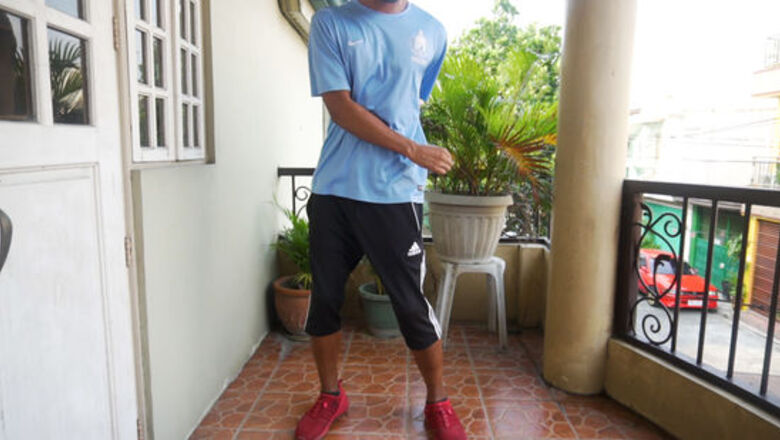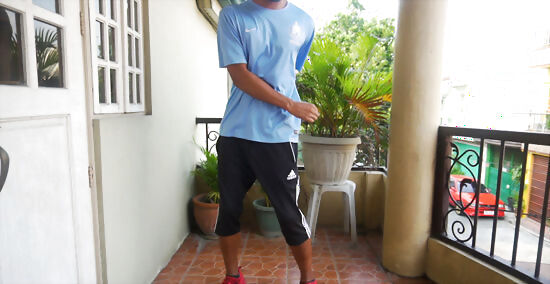
views
Learning the Basic Movements
Pat your thighs and clap your hands. The first movement in the hand jive is to bend slightly at the waist and pat your hands on your thighs twice. After patting your thighs, stand up and clap your hands twice. Instead of patting your thighs, you can also try patting your knees. Choose the motion that is most comfortable for you. You can sit or stand while doing the hand jive.
Crisscross your hands. Standing up straight, cross your right hand over your left hand. After you have crossed your hands, immediately open them again in a quick motion. Both of your palms should be facing the ground. Your hands should not touch each other, but instead, glide past each other in the air. Complete this motion twice. Then cross your left hand over your right in the exact same way. Again, complete this motion twice.
Make your hands into fists. The next move is to make your hands into two vertical fists, as if you were grabbing a pole. Place your right fist over your left fist and knock them together twice. Then put your left fist over your right fist and knock them together twice. This motion is sometimes called the hammer because you are hamming your fists together.
Give a thumbs-up sign. Following the hammer motion, give a thumbs-up sign with both of your hands. Then, beginning with your right hand, point your thumb backwards over your right shoulder twice. This should look almost like you're hitch-hiking. Then complete the same movement with your left arm.
Repeat all the steps. Once you have learned the basic movements, try practicing them in order. Continue to practice until you have memorized the routine and find the movements easy to perform. This should take 5 to 10 minutes depending on your age and dance background. The great thing about the hand jive is that it is a relatively easy dance to learn! Use this video to help you learn and practice the dance: https://www.youtube.com/watch?v=n5FXpc1nPr0
Jiving to Music
Choose a song. The hand jive becomes even more fun if you practice the movements to music. Usually the hand jive is performed to the following songs: “Willie and the Hand Jive,” or “Born to Hand Jive.” Both of these songs have been recorded by multiple different artists over the years. For example, the song “Born to Hand Jive” was popularized in the hit movie Grease. Although these songs are most commonly used for the hand jive, you can perform the dance moves to almost any song. Try choosing an upbeat song that you enjoy and see how it looks. Avoid slow ballads. The jive is supposed to be relatively quick and works best with songs that have a faster beat.
Jive to the beat of the song. Once you are completely comfortable with the hand motions and you have memorized the entire routine, you are ready to try the dance to music. The hand jive lasts for 16 beats (2 sets of 8 counts). In order to perform the movements to music you should count out the 16 beats as your are going through the motions. For example, when you pat your thighs twice count in your head 1...2 to the beat of the music. Then when you clap your hands count in your head 3...4, when you cross your hands (right over left) count 5…6, and then when you cross your hands (left over right) count 7...8. Once you get to 8 counts, you should start over at 1 again. This means when you pound your fists (right over left) you will count 1...2, and then when you pound your fists again (left over right) you will count 3...4, followed by thumbs up over the right shoulder and count 5…6, and finally thumbs up over the left shoulder and count 7...8.
Try jiving at different speeds. The hand jive can also be sped up or slowed down depending on your ability and comfort level. If you want to be challenged while jiving, you can perform the hand jive at double time. This means that the entire jive would only take 1 count of 8 instead of 2. For example, when you pat your thighs twice it would only take up 1 count and you would say 1. Then when you clap your hands twice you would say 2 etc. The beat of the song will stay the same, but you will be performing the motions much faster (i.e. double the speed). If you are already finding the jive difficult, you can also try slowing down the movement. Instead of taking 16 beats (2 sets of 8 counts) you can take 32 beats (4 sets of 8 counts). This means that you would double all of the movements. For example, instead of patting your legs twice, you would pat them 4 times. Continue the dance by doubling all of the movements.
Creating Variations on the Classic Hand Jive
Learn variations to the hand jive. Over the years the hand jive has been modified for various different performances and shows. For example, in 2015 “Grease: Live!” starring Julianne Hough and Carly Rae Jepson updated the dance for a modern viewing audience. In this version of the jive they have removed the hand crossing portion of the dance and replaced it with two flicks of the hands to the right followed be two flicks to the left. Similarly, there are other versions that include a hand roll instead of the hand crossing section.
Try moving your body while you jive. If you feel at ease performing the hand jive in a stationary position, you can also try moving the rest of your body to the music. For example, you could try bopping to the beat of the music, and moving around while performing the hand jive. If you are feeling really creative, you could add in some footwork steps to make the dance even more dynamic and difficult. Remember to always choreograph the moves to counts of 8 in order to stay in time with the music.

Create your own steps. The hand jive is essentially a series of steps that involve moving your arms, and clapping and patting different parts of your body. In many ways, you can think of it as a more advanced form of patty-cake. You can try making your own version of the dance by adding in a series of claps and movements to make it more unique. Dancing is a form of artistic expression so there is always room to show your own personality through the movement of your body. Remember to be creative and have fun!

















Comments
0 comment